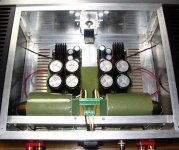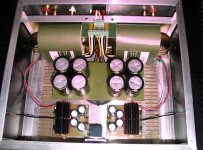Re: 2SC3423/2SA1360
They also have nearly double the Cob.
They are in a different league.
they are about half the speed and only a little faster than the drivers.wai235 said:Is it good to use Fairchild's KSC3503/KSA1381 (F-grade) http://www.fairchildsemi.com/ds/KS/KSC3503.pdf instead of 2SC3423/2SA1360?
It offers good result in simulation
They also have nearly double the Cob.
They are in a different league.
Re: Re: Front End PSU
If you have space for a high quality elcaps, no problem at all with 100 instead of 10uF
pooge said:
What would happen if 100uf is used?
If you have space for a high quality elcaps, no problem at all with 100 instead of 10uF
Mihai,
How do you get DC balance with this amp?
Assuming a low source impedance connected to the input, the non-inverting input would see less than 2k ohms, and the inverting input would see the 22k ohm feedback resistor. This is heavily unbalanced unless an input cap is connected. You must measure the offset with no source connected?
How do you get DC balance with this amp?
Assuming a low source impedance connected to the input, the non-inverting input would see less than 2k ohms, and the inverting input would see the 22k ohm feedback resistor. This is heavily unbalanced unless an input cap is connected. You must measure the offset with no source connected?
pooge said:Mihai,
How do you get DC balance with this amp?
Assuming a low source impedance connected to the input, the non-inverting input would see less than 2k ohms, and the inverting input would see the 22k ohm feedback resistor. This is heavily unbalanced unless an input cap is connected. You must measure the offset with no source connected?
If your source is without an output capacitor you can install one in RMI-FC100.
pooge said:WHERE do you get those R-cores???
Is the capacitor on the input needed for stability, i.e., to extend the bandwidth of the input transistors? If not, and it is only there as an RF filter, can it be removed so an input transformer can be properly used?
R-core? From Paris: http://www.selectronic.fr/magasin.asp#01
Regarding the input capacitor, you need some RF ingress protection in the input stage ...
roender said:
R-core? From Paris: http://www.selectronic.fr/magasin.asp#01
Regarding the input capacitor, you need some RF ingress protection in the input stage ...
Lucky you. The single primaries won't work for North American 117V supply.
An input transformer is bandlimited, so it will protect against RF ingress. I just ask because some use that capacitor in a scheme to extend the bandwidth of the input transistors.
m2003br said:Pooge,
Fets don't have DC current in the gates, unlike bipolars.
Because this, you don't have additional DC offset caused by unbalance in gate resistor values.
Well ... they have some DC, especially if Vds is close to the max limits. Not the case here.
homemodder said:Pooge, for the USA, try electroassemblies.com.
Thanks, but they no longer carry them, and Custom Magnetics has not been very helpful.
pooge said:no longer carry them
Shame, i was hoping some day there'd be sufficient interest in a joint 1.5-2 KVA endeavor.
m2003br said:Pooge,
Fets don't have DC current in the gates, unlike bipolars.
Because this, you don't have additional DC offset caused by unbalance in gate resistor values.
OK. Wasn't thinking. I'm still mired in bipolar mentality.
However, the input cap will drop the load on any input transformer at high frequency, which likes a constant 10k load.
Since an input transformer won't pass DC, the feedback cap can be removed. Since shunting the cap would greatly reduce the DC resistance seen by the inverting input to much less than that seen by the non-inverting input, it is comforting to know that an unbalance with the resistance of the transformer and its load resistor seen by the non-inverting input would not affect offset.
- Home
- Amplifiers
- Solid State
- RMI-FC100, a single stage audio power amplifier


